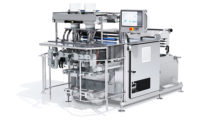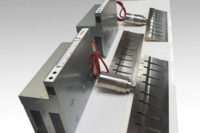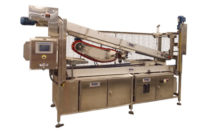A look at recent bagging equipment innovations

Today’s horizontal and vertical bagging equipment helps bakers and snack producers address food-safety concerns, improve operational efficiency and sanitation, and accommodate in-demand packaging, among other capabilities.
“We see a trend toward more automation and food safety initiatives,” says Mathias Lee, vice president of sales and marketing, Spiroflow Systems Inc., Monroe, NC. “Our food industry customers are specifically looking for more automated form/fill/seal systems and robotic bag placements. Food processors also are demanding the best possible sanitary, quick-clean, operator safety design features.”
Lawrence Roos, group product development manager, tna, Sydney, agrees: “We see an increased emphasis on automation and system integration across the entire production line. This optimizes throughput rates, eliminates human error and reduces costs.”
Integrated software control systems, says Roos, offer food processors additional benefits: a single point of control that increases transparency when operating bagging systems, boosting line efficiency and enhancing overall performance. “This is vital, as food processors are looking to achieve ambitious output targets without comprising on quality to remain competitive in a saturated market,” he says.
The trend toward greater automation is fueled by the need for enhanced product traceability, Roos adds. “Food processors must be able to trace a bag back to its origin to ensure the right product is packaged in the correct place,” he says. “Scanning technology paired with SCADA (supervisory control and data acquisition) systems have become the norm in many bakery and snack lines.”
Bag-style versatility
For vertical baggers, stand-up bags with recloseability features, such as zippers, labels and tape are trending, according to Paul Garms, marketing manager, Bosch Packaging Technology, New Richmond, WI. Stand-up bags offer bakers and snack producers a more-sustainable and cost-effective packaging solution than bag-in-box, because they eliminate the need for a cardboard box. Four-corner seal bags and doy-style bags, in particular, are becoming more popular in the United States, he says.
“Critical to creating these bag styles on VFFS (vertical form/fill/seal) machines is forming a flat bottom, so the package remains stable on store shelves,” Garms explains.
Bosch’s SVI 4020 WR forms corner-seal and doy-style bags with optional zippers, as well as simpler styles such as pillow, side-gusseted and stand-up, block-bottom bags. It also can apply zippers, which saves food processors money by eliminating the cost of having zippers pre-applied to film.
The latest high-speed bagging system from Parson-Eagle Packaging Systems, De Pere, WI, can produce up to 100 bags per minute. Designed for paper or plastic pre-made, flat-bottom, side-gusset bags, it features a combination net weigher integrated with a high-speed duplex bag hanger and closing conveyor. Its PC-based scale control system incorporates a touch screen that provides graphic displays of machine status, histograms, setup catalog, and curve analysis.
Weighpack Systems, Montreal, recently introduced the Swifty Junior bagger. Designed to fill and seal pre-made pouches, its compact design makes it a good first step toward automated bagging, especially for smaller companies, says Christie Taraborelli, marketing manager for the company. It handles a variety of bag styles and offers touch-screen controls.
Simple, but efficient
New bagging equipment is also designed to accommodate new food-safety regulations and sustainability initiatives. “We see bakers and snack food producers moving to higher levels of sanitation similar to that seen in the meat and dairy industry,” says Lee.
Food safety and production line efficiency have placed design simplicity at the forefront of product innovation, says Roos. “This encompasses the ability to easily clean equipment and change products online in the shortest possible time,” he explains. “Quick accessibility to system components is paramount and enables manufacturers to easily repair or exchange faulty parts to minimize maintenance time and ensure quick recovery.”
Efficiencies gained through automation may be cancelled out, however, if product is wasted due to spillage or contamination, says Paul Wilkinson, business development manager, Pacepacker Services, Essex, England, adding that such waste is common among manufacturers of bulk ingredients.
“Bagging systems installed at these facilities often are ?lled while on a sack clamp, then dropped onto a moving conveyor and transported to a stitcher,” Wilkinson explains. “All this time, the mouth of the bag is wide open, and the bag is unsupported. This can result in sacks falling over and spilling; it also means that anything—a nut, bolt or insect—could fall in and contaminate the product.”
Pacepacker’s TBC system never releases a sack after it has been ?lled, says Wilkinson. Once a sack is ?lled, a pair of motorized grip arms moves around it. As it drops from the clamp, they close on the top, holding it. The bag is then held shut as it is transported to the sealing device, usually a stitcher or heat sealer. “At no point is there an opportunity for anything to drop into the sack,” he explains. “Also, because the sack is supported throughout the closing process, there’s no risk of it toppling over and the contents spilling.”
Looking for a reprint of this article?
From high-res PDFs to custom plaques, order your copy today!









